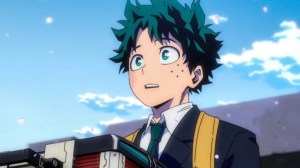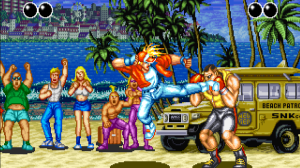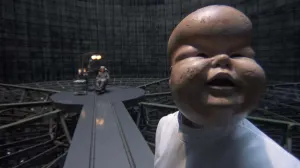The Mighty Thor #705 is the penultimate chapter of Jane Foster‘s time wielding Mjolnir, the final showdown between the current version of Thor and Mangog. It’s a bittersweet moment. As exciting as this final showdown may be, it also signals the end of Jason Aaron and Russell Dauterman‘s collaboration on the character. This run has been nothing short of stunning. Following the explosive debut of Aaron on Thor: God of Thunder, the god lost his hammer in Original Sin only for a mysterious woman to pick up the mantle. That’s where Dauterman came into the picture, transforming the story from impressive to something truly legendary.
Videos by ComicBook.com
Dauterman made an impressive debut at Marvel Comics in 2014 on the series Cyclops with Greg Rucka. It didn’t take long for the artist to move to bigger things. As impressive as his takes on alien species and extraterrestrial fauna were in that series, Thor offered much larger opportunities. It’s on Thor and The Mighty Thor that Dauterman has distinguished himself as one of the best artists working in superhero comics today. He has been the consistent artist for both series for more than three years. It’s an impressive run, and the first great work of what is shaping up to be a stellar career. As the final battle in The Mighty Thor and the end of Dauterman’s run approaches, it’s time to take a look back at what made his work on the series special.
The Wonder of Human Life

We almost saved this feature for last, but it deserves to be highlighted. In a world filled with gods, monsters, and superheroes, Dauterman never allowed these fantastic elements to undermine the essential human core of the story. That’s most obvious in his depiction of Jane Foster. The contrast between Foster as a human battling cancer and Foster as Thor throwing lightning at ice giants could easily diminish the former, but that never occurred in The Mighty Thor. Dauterman managed to consistently depict the terrible realities of cancer and the incredible strength of the people fighting it. Even at her lowest points, a fire burned in Jane Foster’s eyes, and the same could be seen in the friends she made during chemotherapy. It’s easy to make big battles seem heroic, but Dauterman also found the heroism in these much more personal battles.
The Awe of Asgard

Asgard should make regular humans think they’re in heaven. It’s a place that should inspire awe and capture all the majesty that architecture and civilization are capable of. That is one tall order even with the unlimited budget of comics, but Dauterman pulled it off. His vision of Asgard was filled with grand spires, beautifully organized buildings, and seemingly infinite ornate details. Every single time the rainbow bridge appeared in The Mighty Thor it was a promise of upcoming grandeur. That has also made the recent fall of Asgard all the more tragic. Whoever follows in Dauterman’s shoes, it will be tough to rebuild an Asgard of similar greatness.
The Terror of Mangog

Mangog is a Jack Kirby creation that many great artists of the past have found difficult to interpret. He is a bizarre combination of parts with a face, body, claws, and tails that all seem to be grafted from different monsters. Nobody has realized the fury of this terrible creature quite as well as Kirby until it returned in the pages of The Mighty Thor. Dauterman has returned the Mangog to the pantheon of great Thor villains and made him an antagonist capable of fighting even the most powerful gods of Asgard. His mask-like visage is as terrifying as anything in the run so far, and the brutalized and dead characters left in his wake still seem like just the beginning of his savagery.
The Might of the War Thor

This combination of Volstagg and Ultimate Thor’s war hammer created a furious new incarnation of the God of Thunder. It’s a perfect example of how well Dauterman captures the sinew and strength of this mighty superhero comic. While the current Thor is less muscular than current versions, there are still plenty of beasts and heroes based on raw strength. Whether Dauterman was drawing giants or the War Thor, Dauterman filled their bodies with anatomically correct power that made every fight more fearsome.
The Fury of Nature

One of the most impressive elements of any fight featuring Thor for the past several years is the combined movements of Mjolnir and crackling lightning across every panel. Dauterman can construct precise characters well, but he also summons the random fury of nature just as well. Lightning bounces across the page and suns roil with inestimable power as Thor fights and flies through space. The chaos of the natural world is a fundamental element of Thor’s power and it’s a key strength in Dauterman’s compositions.
The Tour of the Nine Realms

A key component of both Thor and The Mighty Thor is the political relations (and eventually war) between all nine realms. Each of these places is a distinct world with landscapes and peoples all their own. Dauterman has clearly put effort into each place Thor has visited, crafting settings filled with history and unique details. Whether a story is set in Hel or Niflheim, it pulls readers into a place they don’t want to leave. Dauterman reminds us of the incredible potential beyond Asgard in every Thor story to come.
The Colors of Matt Wilson

It would be criminal to discuss the impressive work of Russell Dauterman on The Mighty Thor without mentioning his colorist collaborator Matt Wilson. Wilson has made Dauterman’s linework dazzling with a technicolor display capable of capturing the details of individual figures and tone of every incredible realm. He is a dual threat recognizing the key design elements that make unique figures stand out and how to tell a story through color. Battles and conversations are both shaped by Wilson’s colors. Dauterman and Wilson are incredible talents on their own, but together they are a true peanut butter and chocolate combination of comics.
The Mightiest of Tales

What Wilson highlights about Dauterman’s work on The Mighty Thor is that it’s ultimately about storytelling, and they are two of the best visual storytellers working at Marvel Comics today. Every individual panel of their run can be considered stunning for individual reasons. They have captured great battles and emotional moments, epic landscapes and terrifying villains. Yet what really makes this artwork incredible is the story it tells. Every panel connects to make the characters, settings, and battles matter. They enthrall, building tension and empathy for what is on the page. The bottomline with Russell Dauterman’s run isn’t simply that it’s beautiful, but that it tells a story beautifully. As sad as it is to see him leave, we can’t wait to see what’s next either.








